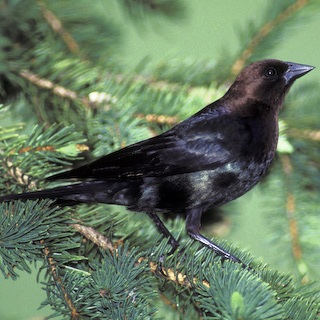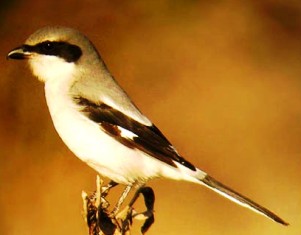Discover Florida Nature
It's time to explore the natural Florida


|
|
|
|
|
 Brown
Headed Cowbird- The Brown-headed Cowbird is a stocky blackbird
with a fascinating approach to raising its young. Females forgo building
nests and instead put all their energy into producing eggs, sometimes
more than three dozen a summer. These they lay in the nests of other
birds, abandoning their young to foster parents, usually at the expense
of at least some of the host’s own chicks. Brown-headed Cowbirds are
smallish blackbirds, with a shorter tail and thicker head than most
other blackbirds. The bill has a distinctive shape: it’s much shorter
and thicker-based than other blackbirds', almost finch-like at first
glance. In flight, look for the shorter tail. Brown-headed Cowbirds feed
on the ground in mixed-species groups of blackbirds and starlings. Males
gather on lawns to strut and display for mates. Females prowl woodlands
and edges in search of nests. Brown-headed Cowbirds are noisy, making a
multitude of clicks, whistles and chatter-like calls in addition to a
flowing, gurgling song. Brown
Headed Cowbird- The Brown-headed Cowbird is a stocky blackbird
with a fascinating approach to raising its young. Females forgo building
nests and instead put all their energy into producing eggs, sometimes
more than three dozen a summer. These they lay in the nests of other
birds, abandoning their young to foster parents, usually at the expense
of at least some of the host’s own chicks. Brown-headed Cowbirds are
smallish blackbirds, with a shorter tail and thicker head than most
other blackbirds. The bill has a distinctive shape: it’s much shorter
and thicker-based than other blackbirds', almost finch-like at first
glance. In flight, look for the shorter tail. Brown-headed Cowbirds feed
on the ground in mixed-species groups of blackbirds and starlings. Males
gather on lawns to strut and display for mates. Females prowl woodlands
and edges in search of nests. Brown-headed Cowbirds are noisy, making a
multitude of clicks, whistles and chatter-like calls in addition to a
flowing, gurgling song. Mockingbird-
The Northern Mockingbird is the state bird for the state of
Florida.
Mockingbirds are best known for their ability to imitate the
sounds of other birds and insects. The mockingbird is a superb songster
with many beautiful melodies of its own as well as the ability to
imitate the songs of other birds and any man made noises that come to
this bird's attention. Mockingbirds are beautiful birds, about the size
of a robin. They are slender, gray birds, with white stomachs and white
patches on their wings and tails. They have a distinctly long tail. The
white patches on their wings are clearly shown when they're in flight,
and their wing beats are slow enough to be counted. Mockingbirds are
very territorial. Mockers are famous for attacking intruders to their
nesting territories. Their targets include cats, dogs, squirrels and
people, as well as other birds. Their diving attacks have reduced many a
household pet to a nervous wreck! They prefer brushy habitats, and can
also be found in residential areas. They lay 3-5 eggs a season. They are
blue-green in color with brownish spots. They tend to nest in bushes or
in a low tree. Baby mockingbirds can be found sitting up straight,
sitting back to back and with their beaks pointed up at the sky. This
helps protect them against predators, and allows them to be on the
lookout for their mama bird when she is off gathering food for them. Mockingbird-
The Northern Mockingbird is the state bird for the state of
Florida.
Mockingbirds are best known for their ability to imitate the
sounds of other birds and insects. The mockingbird is a superb songster
with many beautiful melodies of its own as well as the ability to
imitate the songs of other birds and any man made noises that come to
this bird's attention. Mockingbirds are beautiful birds, about the size
of a robin. They are slender, gray birds, with white stomachs and white
patches on their wings and tails. They have a distinctly long tail. The
white patches on their wings are clearly shown when they're in flight,
and their wing beats are slow enough to be counted. Mockingbirds are
very territorial. Mockers are famous for attacking intruders to their
nesting territories. Their targets include cats, dogs, squirrels and
people, as well as other birds. Their diving attacks have reduced many a
household pet to a nervous wreck! They prefer brushy habitats, and can
also be found in residential areas. They lay 3-5 eggs a season. They are
blue-green in color with brownish spots. They tend to nest in bushes or
in a low tree. Baby mockingbirds can be found sitting up straight,
sitting back to back and with their beaks pointed up at the sky. This
helps protect them against predators, and allows them to be on the
lookout for their mama bird when she is off gathering food for them. American
Robin- The American Robin is a member of the Bluebird and
Thrush family. It's called the 'American' robin because it was named
after a similar (though smaller) bird found in Great Britain. The male
robin's most striking feature is his red/orange breast and belly. They
have gray-brown back and tail feathers with a slightly darker head.
Their white throat is streaked with black and their undertail coverts
are white. They have brown legs and a thin yellow bill that they use for
pecking worms and insects out of the ground. The female robin's coloring
is quite similar to the male, but everything is a slightly paler
color. The young robins also look similar, but have a heavily spotted
breast. The main diet of the American Robin is berries. This is
supplemented by insects, larva and worms. At times, the robin will cock
its head to the side toward the ground. It looks a bit like he's
listening for the worms crawling under the ground, but really he's
watching the ground for the tiny movements that would indicate a worm is
traveling close to the surface. The female robin is in charge of nest
construction. She takes 2 to 6 days to make the nest, using mud mixed
with grass or small twigs. She uses her bill and feet to mould the nest
into a cup shape and then adds a final lining of grass. American
Robin- The American Robin is a member of the Bluebird and
Thrush family. It's called the 'American' robin because it was named
after a similar (though smaller) bird found in Great Britain. The male
robin's most striking feature is his red/orange breast and belly. They
have gray-brown back and tail feathers with a slightly darker head.
Their white throat is streaked with black and their undertail coverts
are white. They have brown legs and a thin yellow bill that they use for
pecking worms and insects out of the ground. The female robin's coloring
is quite similar to the male, but everything is a slightly paler
color. The young robins also look similar, but have a heavily spotted
breast. The main diet of the American Robin is berries. This is
supplemented by insects, larva and worms. At times, the robin will cock
its head to the side toward the ground. It looks a bit like he's
listening for the worms crawling under the ground, but really he's
watching the ground for the tiny movements that would indicate a worm is
traveling close to the surface. The female robin is in charge of nest
construction. She takes 2 to 6 days to make the nest, using mud mixed
with grass or small twigs. She uses her bill and feet to mould the nest
into a cup shape and then adds a final lining of grass. Loggerhead
Shrike - The Loggerhead Shrike is a predator, but it does not
have the strong feet and talons of a raptor. It does have a strongly
hooked bill for gripping flesh, and a strong notch or "tooth" near the
bill tip that helps sever the spinal cord of its prey. It uses thorns
and barbed wire to hold large prey while it rips it up, and may wedge
prey into a fork in a branch for the same purpose. Shrikes are not large
birds, but they are powerful enough to capture prey the size of mice in
addition to insects. A small gray bird the loggerhead shrike has a
distinctive flight. When flying from perch to perch, the shrike will
drop suddenly to nearly ground level, fly the distance close to the
ground, and then ascend sharply to the new perch. The name "shrike"
probably comes from the word shriek, because of this birds shrill call! Loggerhead
Shrike - The Loggerhead Shrike is a predator, but it does not
have the strong feet and talons of a raptor. It does have a strongly
hooked bill for gripping flesh, and a strong notch or "tooth" near the
bill tip that helps sever the spinal cord of its prey. It uses thorns
and barbed wire to hold large prey while it rips it up, and may wedge
prey into a fork in a branch for the same purpose. Shrikes are not large
birds, but they are powerful enough to capture prey the size of mice in
addition to insects. A small gray bird the loggerhead shrike has a
distinctive flight. When flying from perch to perch, the shrike will
drop suddenly to nearly ground level, fly the distance close to the
ground, and then ascend sharply to the new perch. The name "shrike"
probably comes from the word shriek, because of this birds shrill call!
|
|
|
Advertise | Privacy Statement | Contact | Alaska Nature | Michael Arnold Art| Dog Encyclopedia | Dog Encyclopedia| |
|